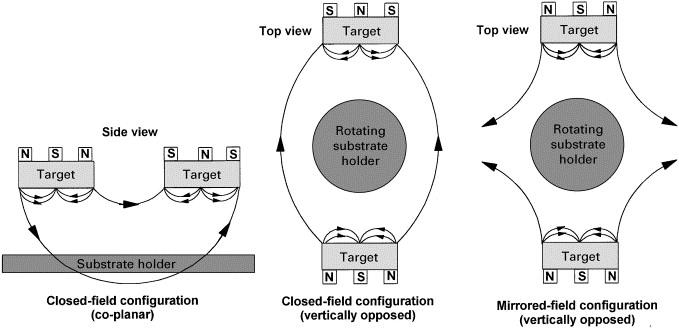Magnetron sputtering is one of the most popular methods for sputter deposition. Powerful magnets confine plasma electrons close to the target. It entails depositing material from a source to a substrate via sputtering using a high magnetic and electric field. It is generally used to deposit alloys, metals, and other materials on a substrate. It was first observed in the 1850s, but little research was done on it until the 1940s.

3 Types of Magnetron Sputtering Films
Sputtered films can be divided into mechanical films and physical films according to their different functions and applications. The former includes surface-enhanced thin-film materials and solid lubricating thin-film materials with functions such as wear resistance, anti-friction, heat resistance, and corrosion resistance; the latter includes thin-film materials with functions such as electricity, magnetism, sound, and light.
- Super Hard Coating: TiN, TiC, and other superhard coatings coat the surface of tools to enhance performance and prolong service life.
- Solid Lubricating Film: commonly used are soft metals(Au, Ag, Pb, Sn, etc.), layered substances (MoS2, WS2, graphite, etc.), polymer materials(nylon, polytetrachloroethylene, etc.)
- Transparent Conductive Film: Its thickness is thin, its transparency is close to that of glass, and its conductivity is close to that of metal, such as indium tin oxide(ITO), aluminum-doped zinc oxide(ZAO), etc. Transparent conductive films are used in liquid crystal displays, touch screens, and thin-film solar cells.
Applications of Magnetron Sputtering Films
Magnetron sputtering is a technological process that has gained wide recognition since the late 1930s. What are some of the applications of magnetron sputtering?
- Data Storage: Magnetron sputtering is used in quite a number of data storage devices. It can be used in the manufacture of DVDs, laser disks, hard disks, floppy disks, micro-electronic flash memory, and CDs. It can also be used in the manufacture of nanostructured materials.
- Aviation: magnetron sputtering is a technique widely used in the aviation and aeronautic industry.
- Automobiles: One of the important applications of magnetron sputtering is its relevance in the manufacture of automobiles. It is used in the production of headlights, taillights, auto trim components, wheels, and rims.
- Jewelry: Magnetron sputtering is used in the manufacture of jewelry. It improves the overall appearance and quality of necklaces, rings, earrings, bracelets, cufflinks, anklets, and other accessories.
- Aesthetics: Magnetron sputtering is involved in producing some aesthetic fixtures, including hardware, glassware, and even toys. It is also used in packaging.
- Sensors: This technology is used in the manufacture of sensors.
- Electronics: One major application of magnetron sputtering is in the manufacture of electronic appliances. Some of the electronic appliances made by magnetic sputtering include gate dielectric, passive thin-film components, interlayer dielectric, printed circuit boards, and surface acoustic wave devices.
- Energy: Gas turbine blade coating, outdoor display systems, and solar panels are some magnetron sputtering applications. The aforementioned are used in generating energy. Therefore, magnetron sputtering has a role to play in generating energy.
- Plumbing: Magnetron sputtering is used in coating some plumbing fixtures to prevent corrosion and rusting.
- Lighting: This is another important application of magnetron sputtering. Traffic signals, IR intensifiers, energy-efficient lighting, emission filters, and effectors.
- Medical: In the medical field, Magnetron sputtering is also of great importance. It is used in the manufacture of angioplasty devices, anti-rejection coating, which prevents allergic reactions, radiation capsules, and dental implants.
- Security: Magnetron sputtering is also relevant in security. Technological innovations like night vision, infrared equipment, one-way security windows, and currency holograms benefit from magnetron sputtering.
- Optics: Anti-reflective coatings, cable communications, laser lenses, optical filters for achromatic lenses, and spectroscopy rely on magnetron sputtering technology. In this way, magnetron sputtering contributes to optics.
- Anti-corrosion: magnetron sputtering is used to coat wares. These wear layers become more resistant to corrosion, friction, and wear. Thus, they are more durable.
Materials Used for Magnetron Sputtering
- Magnetic materials such as nickel or iron.
- Sputtering Sources
- Sputtering Materials
- Substrate
- Cathode
- Magnetron sputtering system
Advantages of Magnetron Sputtering
- Magnetron sputtering is used to deposit a wide range of materials. It is versatile.
- The material used does not have to be melted and evaporated.
- The films are neatly and evenly deposited on the substrate.
- The films formed by magnetron sputtering have high purity and are compact.
- The size of the film particles can be regulated.
- Alloys, metals, and oxides can be combined and used on a substrate via magnetron sputtering.
- Ability to deposit a film on heat-sensitive substrates.
Disadvantages of Magnetron Sputtering
- The plasma used can be unstable.
- The target’s utilization rate is low.
- It is an expensive process.
Conclusion
Thank you for reading our article, and we hope that it can help you better understand magnetron sputtering films. If you want to know more about sputtering knowledge, we would like to advise you to visit Stanford Advanced Materials (SAM) for more information.




